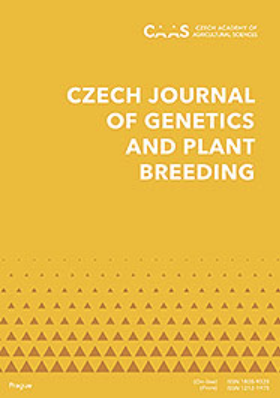冬小麦品种对眼斑病反应的目测和实时PCR分析
IF 1.8
4区 农林科学
Q3 AGRONOMY
引用次数: 3
摘要
在2017-2018年的小小区试验中,评价了捷克12个常熟冬小麦品种和25个新选育品系对黄斑黑穗病(Oculimacula yallundae)和acuformis的接种反应。通过视觉症状和定量实时聚合酶链反应(qPCR)进行评估。本研究的目的是比较两种方法的结果,评价Pch1基因对眼斑病的抗性效果,并筛选出抗眼斑病的新品种。眼斑症状与植物组织中病原菌DNA含量之间呈中度线性回归关系。在具有Pch1抗性基因的品种/品系(Annie、Hermann、Rebell、SG-S1215-14、SG-S1825-14、SG-S791-13)和SG-SU630-15中观察到低水平的眼斑。qPCR方法能够检测到植物组织中低水平的病原体,并区分出两种眼斑病原体。在接种植株中检测到的针叶虫的浓度与黄叶虫相比极低。由于2018年春季气候极端干燥温暖,2017年眼斑感染率明显高于下一农季。本文章由计算机程序翻译,如有差异,请以英文原文为准。
Reaction of winter wheat cultivars to eyespot assessed visually and by real-time PCR
The reaction of twelve winter wheat cultivars frequently grown in the Czech Republic and twenty-five new breeding lines to inoculation with Oculimacula yallundae and Oculimacula acuformis was evaluated in small plot trials from 2017–2018. The assessment was carried out visually by symptoms and by a quantitative real-time polymerase chain reaction (qPCR). The aims of the study were to compare the results of both methods, to evaluate the effect of the resistance gene Pch1 to eyespot, and to select new breeding lines resistant to eyespot. The relationship between the eyespot symptoms and the pathogen DNA content in plant tissues followed a moderate linear regression. Low levels of eyespot were observed in the cultivars/lines possessing the resistance gene Pch1 (Annie, Hermann, Rebell, SG-S1215-14, SG-S1825-14, SG-S791-13) and also in the line SG-SU630-15. The qPCR method was able to detect low levels of the pathogens in the plant tissue and to distinguish two eyespot pathogens. O. acuformis was detected in very low concentrations in the inoculated plants compared with O. yallundae. The eyespot infection rate was significantly higher in 2017 than in the next agricultural season due to extremely dry and warm spring weather in 2018.
求助全文
通过发布文献求助,成功后即可免费获取论文全文。
去求助
来源期刊

Czech Journal of Genetics and Plant Breeding
Agricultural and Biological Sciences-Plant Science
CiteScore
2.20
自引率
0.00%
发文量
25
审稿时长
>12 weeks
期刊介绍:
Original scientific papers, critical reviews articles and short communications from the field of theoretical and applied plant genetics, plant biotechnology and plant breeding. Papers are published in English.
 求助内容:
求助内容: 应助结果提醒方式:
应助结果提醒方式:


